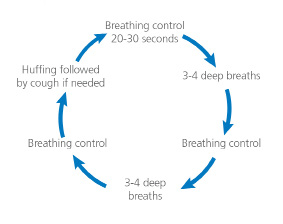A patient’s guide to the active cycle of breathing technique (ACBT)
Read our guide below about the active cycle of breathing technique.
You can also download a PDF version of this patient information by following the link on the right.
What is the active cycle of breathing technique (ACBT)?
It’s a simple cycle of breathing exercises to:
- loosen and clear mucus (secretion, sputum or phlegm) from your lungs
- improve ventilation in the lungs
- maintain the health of your lungs.
This information will remind you of what you learned from your physiotherapist or respiratory nurse.
Components of ACBT
Firstly, find a comfortable position. Leaning slightly forward or sitting upright in a chair are good positions.
Relax your neck, upper chest, shoulders and arms.
Breathing control – relaxed breathing
Remember to:
- do relaxed, normal breathing using your diaphragm (tummy)
- feel your tummy gently rise as you breathe in and fall as you breathe out
- breathe in and out through your nose, quietly if you can.
Do breathing control for as long as you need too, (say 20-30 seconds?). If you’re more breathless you may need to do this for longer until your breathing settles.
Deep breaths
Remember to:
- take deep breaths which help you get air behind the mucus
- take a deep breath in, slowly though your nose.
- breathe out gently through your mouth.
Sometimes it’s helpful to hold your breath for 2 to 3 seconds at the end of the breath in, before breathing out.
Huffing
A huff involves exhaling through an open mouth and throat instead of coughing.
It helps move sputum up the airways.
Take a breath in through your nose then imagine you are trying to steam up a mirror in front of you – exhale forcefully through an open mouth.
Rest/perform breathing control after each huff.
Cough
You may not need to cough if huffing is successful.
If you feel your secretions have loosened then try a cough to clear them.
Repeat the cycle for about 10 minutes until your chest feels clear of mucus (phlegm) or until you feel tired and need to rest. If you have more mucus you may need to repeat the cycle for longer than 10 minutes.

About our patient information pages and leaflets
This patient advice is intended as general information only. We aim to make the information as up to date and accurate as possible, but please note that it is subject to change.
Always check specific advice on any concerns you may have with your doctor.
